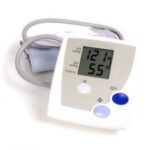My husband and I are preparing to move to Germany in a couple of months, courtesy of the U.S. Army. As part of the process for completing that move, I had to submit to a physical examination. I was really dreading my physical, mainly because I hate to hear bad news. I’m a lot heavier than I’d like to be and I hate being someone’s patient. Nevertheless, I knew I had to bite the bullet, so I made an appointment at DeWitt Army Community Hospital, our local military treatment facility here on Fort Belvoir.
I showed up for the appointment on June 5th, feeling very apprehensive about the whole thing. The nurse who took me back to check my vital signs could tell I was nervous. She advised me to try to calm down so that my blood pressure wouldn’t be high. I’ve never had a problem with my blood pressure, although I do have close relatives who take medication to lower their blood pressure.
Blood pressure is the measurement of the force which propels blood through a person’s blood vessels. When blood is pushed through the blood vessels with too much force, it can cause internal damage to the body and increase the risk of heart disease, stroke, and kidney disease. High blood pressure, also known as “hypertension”, is called the “silent killer” because it doesn’t usually produce symptoms. The only way most people know they have high blood pressure is by having it measured by a blood pressure monitor.
Health professionals measure blood pressure with two numbers divided by a slash. The first number is called the systolic pressure. It represents the measurement of the force when the heart pumps. The second number is known as the diastolic pressure. It’s the force measured as the heart relaxes between beats. A person’s blood pressure is considered high when they have readings greater than 140/90. Pre-hypertension starts at 130/80.
Despite my best efforts to relax, my blood pressure was pretty high at 144/90 when the nurse took it. My primary care provider, a very astute physician’s assistant, told me that she was concerned that I might have high blood pressure. She asked me to keep a blood pressure diary for two weeks by coming into the clinic and having my blood pressure taken at random times.
For two weeks, I showed up at the internal medicine clinic at DeWitt, wrinkled diary in hand. I’d sit in the waiting room, wait to be called back, and get my blood pressure taken and recorded. The results of the diary were interesting. On one occasion, I had a borderline high reading. Twice, my readings were completely normal, and twice, they were considered high. Almost every time, my pulse was racing. One time, it was 112 beats per minute, which is definitely not normal for me. I pulled out our home blood pressure monitor and started checking my blood pressure at home. I noticed that when I was at home, my blood pressure and pulse were completely normal.
On my follow up visit to see the physician’s assistant, I handed over the diary. She was about ready to conclude that I had high blood pressure, but then I told her that my readings outside of her office were consistently normal.
“You might have what we call ‘white coat hypertension’.” she said. “If you have white coat hypertension, your blood pressure will show up as high in a clinical setting, but normal anywhere else.”
I had heard of white coat hypertension and knew what it was. But then the physician’s assistant made a suggestion.
She said, “I’d like to have you placed on an ambulatory blood pressure monitor for a day. That way, if you really do have white coat hypertension, we can document it and you won’t have doctors down the line so worried about these high readings. As it stands now, I could diagnose you with high blood pressure.”
I asked her what the test entailed. She told me I would wear a monitor for twenty-four hours and it would record my blood pressure every twenty minutes until about 11:00 at night. Then, while I was sleeping, the monitor would record my blood pressure once an hour. That way, she could see what my readings were like outside of the clinical environment. The test didn’t sound like it would be a lot of fun, but I realized that the results could be valuable once I get to Germany. There would be documented proof that outside of a hospital environment, my blood pressure is normal.
I made the appointment for the test. I was given instructions that told me I should be sure to wear a loose fitting, short sleeved or sleeveless shirt. I would not be able to bathe or shower while wearing the monitor. I also couldn’t have x-rays taken, use an electric blanket, or stand too close to a microwave.
On July 11th, I showed up at the hospital wearing loose fitting clothes and met a doctor who fitted me with the monitor. She put a belt around my waist with a Walkman sized monitor attached to it. Then, she ran a tube under my shirt and through my sleeve which was attached to a normal looking blood pressure cuff. She wrapped the blood pressure cuff around my left arm and tested the machine. My pressure read fairly high at 131/90. The doctor gave me a diary and told me to record the times when I exercised, went to sleep, and woke up. She added that the monitor was a computer and would track all of my readings for me. There was no need to take note of the readings myself in the diary. Apparently, she had recently had a patient who had actually taken the time to record all of her blood pressure readings!
So I went home with the monitor strapped to my arm and waist. A few minutes after I left the hospital, I felt the blood pressure cuff start to inflate. I stopped, relaxed my arm, and let the machine take the reading. I looked down at the small screen on the monitor and saw that my reading was a relatively normal 121/80. Twenty minutes later, it had dropped even further and the trend continued throughout the day, even dropping to 105/60 a few times. Unfortunately, my arm soon got bruises and a rash from the repeated readings. By that evening, my arm was a bit uncomfortable, but I was able to sleep for a few hours. To my surprise, once I fell asleep, I didn’t wake up when the machine measured my blood pressure.
On July 12th, I went back to the hospital so that the doctor could take the monitor off of me. When she called my name, she noticed that I couldn’t get to her fast enough. I was really ready to be rid of the monitor, but certain that the results would be good news. When she removed the blood pressure cuff, I showed her my arm, which had red streaks on it from where bruises had formed. The doctor said the bruising was very common. They didn’t hurt; they just looked ugly.
On July 13th, I saw my physician’s assistant and told her that I thought she’d be pleased with the test results. Later that day, she called me and gave me my official diagnosis… white coat hypertension. There would be no need for treatment right now!
Ambulatory blood pressure monitoring is a safe, relatively painless test that may prevent false hypertension diagnoses. Since I’m a military dependent and had my test done at a military hospital, I didn’t have to pay to have it done. I don’t know how much ambulatory blood pressure monitoring costs at a civilian facility, but considering how much prescription drugs cost and the potential risks of taking medications, it’s probably a worthwhile expense. I’m sure glad I did it!





